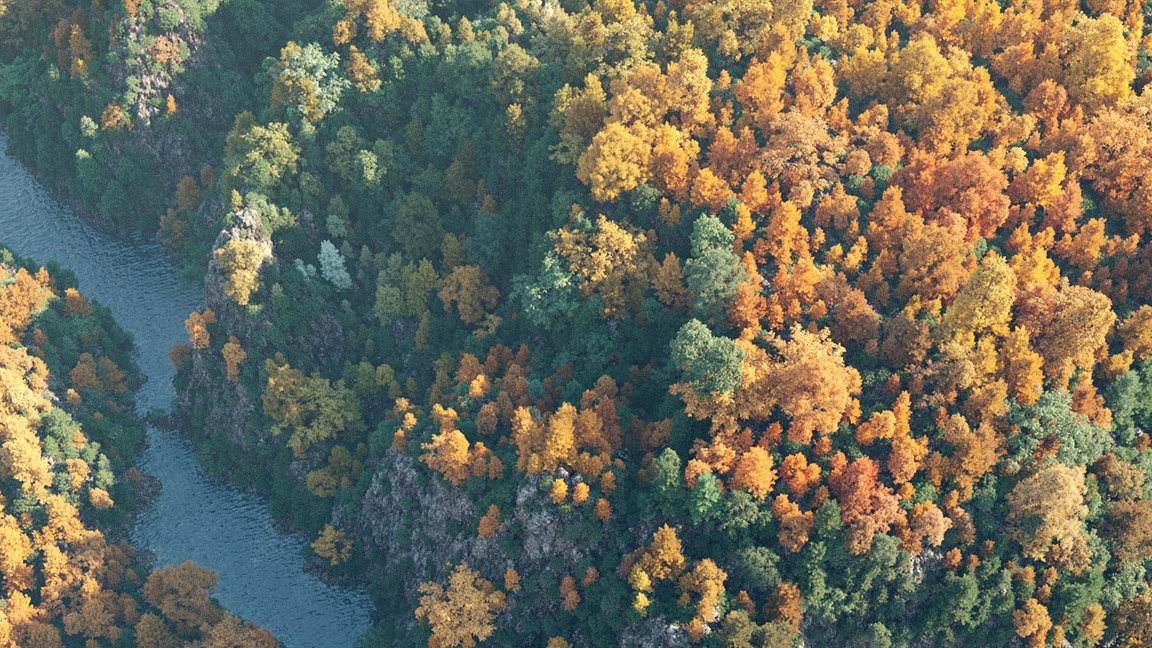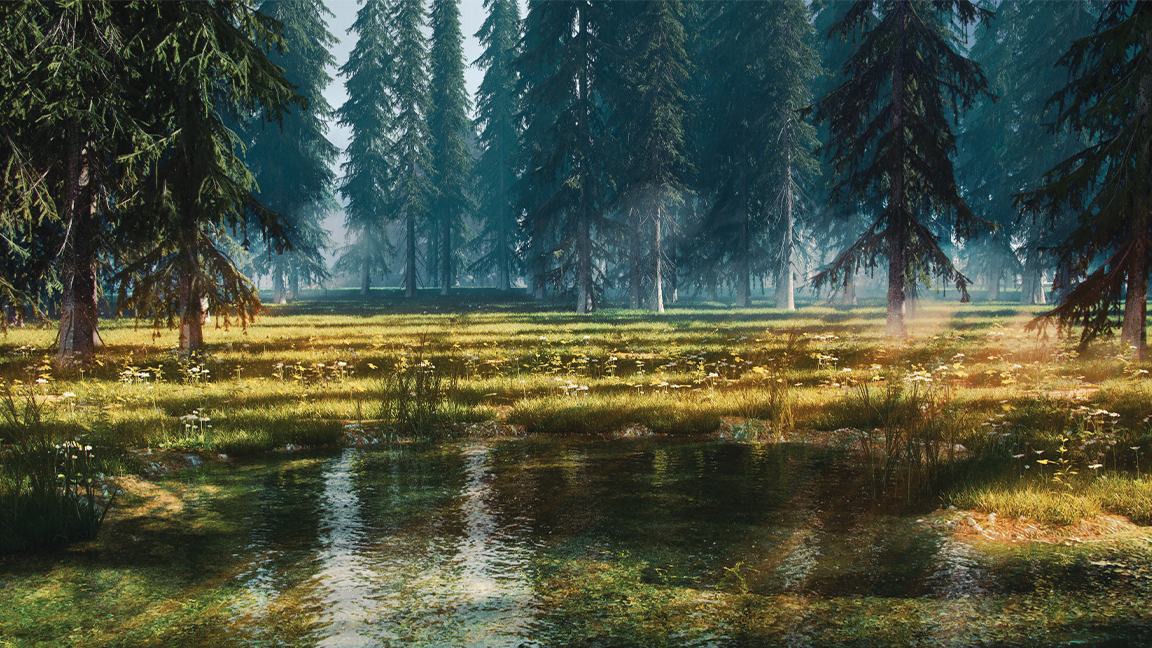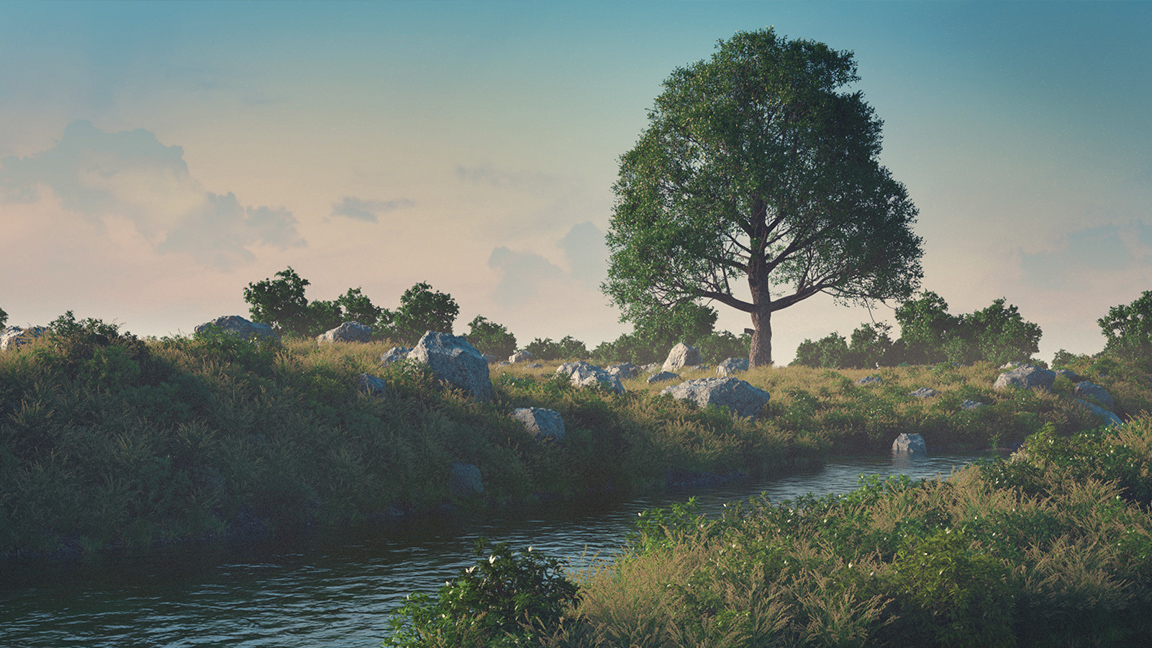The best CG scattering tools for 3D artists
Speed up your CG workflow with the best scattering tools for Cinema4D, V-Ray and more.

In the early days of CG, when scattering tools were very much few and far between, 3D artists had to create a whole host of complicated workarounds to create even remotely believable results.
Even when scattering tools like Forest Pack hit the market, we still had to follow processes like Peter Guthrie’s famous grass creation tutorial to get the right objects to then scatter. I made use of Particle Flow in 3ds Max in those early days and I’m getting the sweats just thinking about it now. It was complex, laboured and unbelievably difficult to get good results.
Early releases of scattering plugins provided the necessary tools to duplicate objects over terrains and various properties could be tweaked to determine the density of the scattering. By adjusting position, scale and rotation, artists could create something that resembled realism.
The tools have of course evolved and become more expansive, with new players entering the market at the same time. One of the biggest changes has been the provision of ready-to-go models that can be scattered. These include vegetation, grass and flowers amongst others, and the introduction of these models has made the creation of forests and fields as simple as a few clicks of the mouse. Workflows today are completely unrecognisable from a decade ago.
Take a look at our 20 essential resources for Maya guide, as well as our 10 top 3ds Max resources feature for more free and cheap ways to expand your workflow. Read my Unreal Engine 5 review and ZBrush 2023 review for the latest software, too.
In my scattering tools plugin roundup I have tested, rated and reviewed a selection of the best scattering tools available to us by 3D artists, to help you determine which are the best fit for your own projects.
The best CG scattering tools for 3D artists


01. Forest Pack
Our expert review:
Specifications
Reasons to buy
Forest Pack is a heavyweight in the scattering market. For over a decade the tool has been making the impossible possible by enabling artists to scatter an unbelievably huge number of objects in a hassle free manner.
Whereas Chaos Scatter is limited to Chaos products V-Ray and Corona, one of the major benefits of Forest Pack is that it is compatible with all the main render engines, including V-Ray, Corona, Arnold and Octane to name only a few; so if you’re after a powerful tool that is compatible with a range of renderers, Forest Pack is a cracking option. This is particularly useful for larger studios who may use more than one renderer in their pipeline. That being said, at the same time as being compatible with major renderers, this is a plugin only for 3ds Max. Users of other software, such as Cinema 4D, have to turn to other options.
Most artists will make use of scattering tools for distributing vegetation. Forest Pack is able to scatter other objects, but in the most recent major release (v7.0) the developers have made it possible to scatter any type of object. This increases the real-world uses of the product and makes it even more versatile than it already was. A notable example of this is with the ability to now scatter lights. By introducing this extended functionality, Forest Pack is again reducing the need to carry out manual tasks when creating scenes.
The ability to export to Unreal Engine, Unity and Chaos Vantage means this tool fits nicely into broader pipelines
Support for real-time engines is also becoming increasingly important in artists’ and studios’ workflows. The ability to export to Unreal Engine, Unity and Chaos Vantage means this tool fits nicely into broader pipelines.
If you need any other reason to think about trying Forest Pack, then this should tip the scales. Amazingly, there is a Lite version that is free to use even for commercial purposes. That’s incredible.
For simpler projects and small scenes, the Lite version will be more than enough. As you’d expect, the Lite version does have some limitations. Users can only scatter three different objects across four areas, but more notable than that is that the areas have to be flat. This is a major limitation considering that most landscapes will have undulations and variety.
These limitations will put a lot of people off, but at only just over $330 / £234 per year the full version is hardly a massive dent to the budget.

02. Forester
Our expert review:
Specifications
Reasons to buy
Reasons to avoid
Forester, a scattering plugin for Cinema 4D, has positioned itself similarly to Forest Pack (my No.1) in its focus on trees, plants and rocks. It does this through the use of four different modules. Three of the modules are focused on the actual content: Forester Trees, Multiflora and Forester Rock. Trees and plants can be created from scratch or library items chosen instead.
From my experience, most artists simply make use of the content contained in the libraries. The preset content is both varied and photorealistic, meaning they can be relied upon to slot straight into your projects. I’d like to have seen more palm trees in the library, so if your projects are largely located in parts of the world where these trees are common then you might want to give some thought as to whether Forester is for you.
On top of these libraries of models, Forester also offers expansion packs to provide even more trees and plants. I’m not personally a fan of this approach. From an artist's point of view I just want everything contained within one package rather than having to fork out an extra amount of money for a few extra trees. Forester takes this approach with rendering compatibility as well. The default package provides Cinema 4D standard materials and only with the expansion packs can artists gain access to materials that are compatible with the likes of V-Ray, Redshift and Corona.
If you need the flexibility to create bespoke results then Forester’s tools are pretty good
The easy preset route is not for everyone though. If you need the flexibility to create bespoke results then Forester’s tools are pretty good. The whole setup is procedural, which makes it easy and straightforward to mix things up. This is especially useful if vegetation makes up a big portion of your projects and you want to avoid every project looking the same.
Aside from the content creation tools, Forester has the MultiCloner module which drives the scattering. The algorithms are able to handle an impressive number of scattered objects, even with the most complex of parameters. A particularly impressive fact is that Forester has a detailed video for every feature of it, which means you’re never left in the dark as to how it functions.
A hugely beneficial advantage of Forester is its wind effects, as part of its HyperWind technology. Vegetation that moves in the wind has historically been a bit of a holy grail, but Forester is managing to achieve some pretty impressive results.

03. MultiScatter
Our expert review:
Specifications
Reasons to buy
Reasons to avoid
iCube 3D has been prolific in creating plugins for Digital Content Creation (DCC) tools. They have the likes of VRayPattern and CityTraffic as well as a popular scattering tool called VRayScatter. It is this existing plugin that provided the foundation for MultiScatter. Being able to scatter trees with V-Ray isn't new, but this new plugin does it extremely well.
VRayScatter, as you can imagine, is limited to a single renderer, V-Ray. With a plethora of renderers on the market, it made sense for the developers to diversify and that’s why we’ve got MultiScatter. It is compatible with V-Ray, Arnold, Corona, Octane and Maxwell as well as others. This wide compatibility is appealing for artists who are not hitched to just a single renderer, and who don’t want to switch scattering software whenever they switch renderer.
Despite MultiScatter’s compatibility with multiple renderers, it currently only has a 3ds Max version. This is quite common in the scattering market, with each application generally available for only one DCC tool. That being said, at the time of writing, MultiScatter for Maya is in beta development. This is a big positive because it further extends MultiScatter’s usability across a broader 3D workflow and pipeline.
There are some situations where MultiScatter adapts more easily, and at these occasions it comes into its own
MultiScatter is designed to scatter any type of object. Its main competitors are more suited to scattering vegetation, but MultiScatter has purposefully maintained its general application. This means that there are some situations where MultiScatter adapts more easily, and at these occasions it comes into its own.
One of its main selling points is that the licence is not only very reasonably priced, but it is also a lifetime licence. This approach is remarkably rare in the software industry, so MultiScatter is a bit of an outlier in that regard. This will appeal to smaller studios and individual artists, but this benefit does come with a couple of big caveats. The first is that MultiScatter is rarely updated. If its history is anything to go by, then major features are few and far between with an annual update not being the norm.
Secondly, the support is not particularly extensive and the forum community is not overly active. If you have a problem then you’ll be forgiven for feeling on your own. MultiScatter still has a place in the scattering market, but without more focused development it does run the risk of falling behind its more active competitors.

04. Chaos Scatter
Our expert review:
Specifications
Reasons to buy
Reasons to avoid
Chaos Scatter is a relative newcomer to the scattering scene. It is available to both V-Ray and Corona users and is built upon technology that used to be named Corona Scatter. The provision of a scattering tool in these renderers will please existing users, because it’ll make their workflow and pipelines are much more straightforward and seamless. Artists are guaranteed that the materials they’ve set up using either of those two renderers will work perfectly with Scatter.
Scatter is very much a work-in-progress though, probably more so than some of the other available options. Chaos has decided to get Scatter to market by shipping it with both V-Ray and Corona, but their forums communicate how much work they still have to do on it. This is one thing I love about Chaos.
First of all, the team is not afraid of releasing software which isn’t perfect and secondly, they’re upfront about the work that still needs to be done on it. They are proactive and take the views of the community on board. An example of this is where Scatter lacks the same capabilities that Forest Pack’s has in the area of clumping. There are many natural things that clump together rather than spread evenly, so it’ll be good when this is added in a future update.
Scatter users will benefit every time Chaos builds on and improves its Cosmos collection
Most scattering tools come with a set of models that can be scattered. These are either included as part of the package or some are at an additional cost. Chaos is taking a slightly different approach by linking it with one of its other products in their ecosystem, namely Chaos Cosmos. This is a collection of top-quality assets that are ready to go with V-Ray and Corona renderers. The immediate advantage of this approach is that Scatter users will benefit every time Chaos builds on and improves its Cosmos collection.
As Chaos lacks a number of the features that its competitors have, I don’t think it’ll be prolific in drawing people away, at this stage, from the likes of Forest Pack. But, I think it’ll be particularly effective in attracting artists who are new to the possibilities of scattering and who are existing V-Ray and Corona users. The ease of having everything to hand and included in the monthly subscription will be very appealing to many.
CG scattering tools: my conclusions
There are a plethora of scattering tools available on the market, but because they often hitch themselves to a single DCC tool there isn’t always a huge amount of choice for your chosen DCC. We’ve reviewed two options for 3d Max, one for Cinema 4D and one that is linked to V-Ray and Corona renderers. If you’re a Rhino user there’s Rhino Nature, or Maya artists can make use of a MASH and SpeedTree workflow. If any of the scattering tools were to make themselves accessible across several of the main DCC tools, then I think they’d rake in the market share.
For the general feature set I think Forest Pack wins. It is comprehensive, extensive and benefits from regular updates, something that MultiScatter really lacks. Forester comes close, but only by purchasing the two expansion packs which adds several hundred dollars and pounds onto the cost of the software. Chaos Scatter is the newest beast to the market and this is shown in its more primitive set of features. Chaos Scatter will become stronger over the years, but if you need something that delivers on every front, right now, then you’ll need to find a different option.
Alongside their scattering features, a lot of the tools are centred around vegetation and therefore offer large tree and plant libraries. Forest Pack and Forester are specifically lined up for this with both model libraries and tools to create bespoke results. Chaos Scatter has taken a slightly different approach by linking itself with another Chaos product, Chaos Cosmos. This is Chaos’ library of smart models with V-Ray / Corona materials built-in.

One of the most important elements of any scattering tool is its performance, especially if you’re dealing with huge scenes with multiple different types of scattered objects. Forest Pack, as well as Forester, have benefited from years of development, testing and improvement, meaning issues have largely been identified and worked through resulting
in well-honed scattering solutions. MultiScatter has also benefited from being time-tested but the lack of ongoing regular and focused development, compared to its competitors, does leave it vulnerable to lagging behind. Scenes are becoming more complex, models and shaders are more advanced, and artists more adventurous, so any tools that want to stay in favour will need to adapt to the changing times.
As mentioned in its review, Chaos Scatter is only at version one and despite being built on Corona Scatter technology is still very much in the early stages of its lifespan. With Chaos Scatter you’ll encounter a stable release but it’s nowhere near as refined as Forest Pack, for now.

The examples we’ve reviewed range in price and type of licence. Chaos Scatter is shipped with both V-Ray and Corona which means you get access to it for only £$30 / 30 per month. This will be a dream come true for existing users of these renderers because they’ll enjoy scattering tools for no extra money. For some, the introduction of Chaos Scatter may tempt them away from other renderers and onto Chaos alternatives instead.
Next up is MultiScatter coming in at only £170, a one-off payment in return for a lifetime licence. Forest Pack enters the fray at an annual subscription of £234 with add-on model packs at £99 each. Last up and most expensive is Forester at around £400. This is quite a leap and with each of the two expansion packs costing a further £120 you can understand why it’ll put solo artists off.
In conclusion, for 3ds Max I don’t think you can beat Forest Pack at the moment. It’s reasonably priced and includes regular updates. If you’re looking for something cheaper without an annual subscription then MultiScatter will serve you well. Forester might be a good option for Cinema 4D users, but if you’re a V-Ray or Corona user then Chaos Scatter is a great choice.
This article was originally published in issue 292 of 3D World Magazine. You can subscribe to 3D World at the Magazines Direct website and get 3 issues for £3. The magazine ships internationally.
Read more:
- The best HP laptops
- Unity: the next-gen CG tech every artist needs
- ZBrush review: digital sculpting has never been easier

Thank you for reading 5 articles this month* Join now for unlimited access
Enjoy your first month for just £1 / $1 / €1
*Read 5 free articles per month without a subscription

Join now for unlimited access
Try first month for just £1 / $1 / €1
Get the Creative Bloq Newsletter
Daily design news, reviews, how-tos and more, as picked by the editors.

Paul is a digital expert. In the 20 years since he graduated with a first-class honours degree in Computer Science, Paul has been actively involved in a variety of different tech and creative industries that make him the go-to guy for reviews, opinion pieces, and featured articles. With a particular love of all things visual, including photography, videography, and 3D visualisation Paul is never far from a camera or other piece of tech that gets his creative juices going. You'll also find his writing in other places, including Creative Bloq, Digital Camera World, and 3D World Magazine.
- Ian DeanEditor, Digital Arts & 3D
